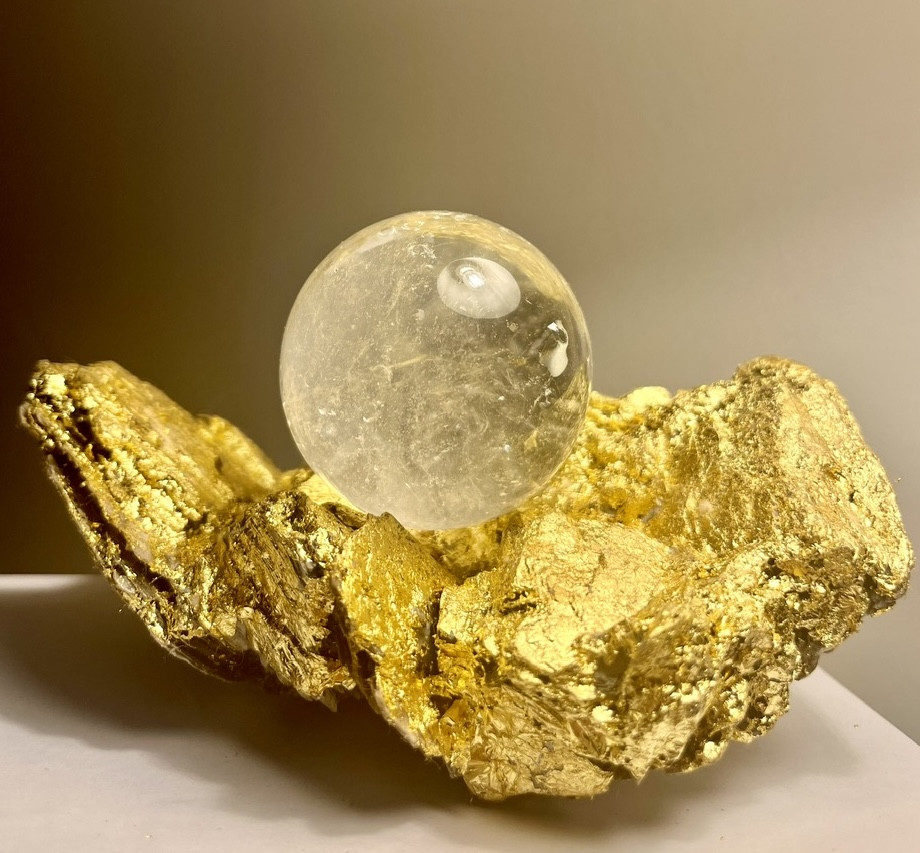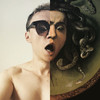Play and Vernacular Reversals of the Heroic in Maria Ruzaikina’s Interdisciplinary Artistic Practice
Arguably, the most complex task of the creative is to utter the unspeakable — aesthetically communicating the dilemmas of the human condition to the audience. The artist as “a lonely genius” is a myth created by historians and marketers. The genuinely authentic creator interconnects the media, times and geographies by instituting unconventional communications and dialogues between the realms of knowledge, aesthetics and humanities removed from the ordinary of the everyday. The intricate art of Maria Ruzaikina synergises traditional crafts with transdisciplinary contemporaneity, paving the way towards creating new languages of artistic expression.
Maria Ruzaikina transcends conventional boundaries, weaving together the ancient crafts of gilding and bookbinding with the transformative potential of sculpture and installation. This artist’s unique mastery lies in using precious metals — gold and silver — as mediums, breathing life into their creations with a touch of almost alchemical magic. These crafts serve as the canvas upon which their narrative unfolds. The objects serve as vessels for stories, memories, and emotions. By merging these practices, the artist transcends the conventional notion of books, transforming them into tangible, three-dimensional sculptures that bridge literature and contemporary visual art.

For the Heroic Works International Bookbinding Competition in 2017, she created a spectacular hand-tanned leather binding Epics with gold and silver incisions for the book “Bylini” (1918) by Boris Sokolov. The complexity of the technical execution of the work matches the conceptual framing of the project. “Bylini” delves into the rich culture of Slavic oral storytelling and presents the collection of the most prominent narratives from the vernacular culture. Assembled and published in the aftermath of the revolution, which toppled the imperial regime and opened a space for the possibility of radically democratic culture, the work focuses on the vernacular tellings of the stories and the meaning that it conveyed for the generations of inhabitants of the villages. Ruzaikina“s spectacular leather-incised work is playful and emotional. It depicts the wondrous monsters of the Slavic folklore — Firebird and Zmei. The lustrous gold details make them into heavenly creatures, twisting the perception of fearsome into subjects of desire. Ruzaikina estranges these monsters, in Sara Ahmed”s sense of the verb, defamiliarises them and creates a distance that opens new possibilities for interpretation. The artist masterfully places this agency in dialogue with Sokolov’s book attempt to explore the vernacular roots of wondering about the narrative, not othering or controlling someone through it. The radiant sun disc-eye pupil, as if in the restitution of the pluralistic polytheist naturalism, unites the creatures with its rays while the serpent tale, as if a tree trunk, grows from the foundation of the work, indicating regeneration and cyclical origins of storytelling.

For the same competition several years later, she submitted Peas (2022) — a work in leather, gold and silver, which pays homage to Gregor Mendel, the nineteenth-century founder of modern genetics. Mendel meticulously experimented with cross-breeding peas to achieve new colouration of the peas in pods. He mathematically worked out recessive and dominant traits in the plant, paving the way for the same logic to be applied to other living organisms. Ruzaikina’s artwork, a beautiful leather bound for Mendel’s collection of observations, is starkly simple and ludic. The roundels, representing peas, are stacked vertically one on another, covering almost the entire surface of the work. This makes them look like the Mesopotamian backgammon with peas like the game pieces in shiny and soft gold, silver, light green, deep black and white. Ruzaikina’s engages with the notion of a game in scientific discovery, highlighting the simple pleasure of wonder accompanying any eureka moment, surrounded by hard work and numerous hours of experimentation. Her work captures the invisible yet omnipresent essence of curiosity, which undoubtedly played a paramount role in leading Mendel towards laying the founding stone in genetics.
The incorporation of sculpture elevates the artist’s creations to different heights. Gold and silver, with their intrinsic allure and symbolic weight, become the very essence of these sculptures. The artist moulds and shapes these precious metals, giving form to abstract ideas and evoking a sense of luxury and transcendence. Through this process, they transmute the mundane into the extraordinary, crafting sculptures that captivate and enthral.
Ruzaikina’s Wondering Rocks (2023) presents the materialisation of a complex literal strategy in artistic rendering. Interpolations — seemingly unrelated events in the narrative, happening simultaneously and offering a wide-lens angle of observation of the scene, as if four-dimensionally mapping it — are crucial for James Joyce in his seminal “Ulysses”. In his time, the author offered a deep introspection into the ontology of Homer’s “Odyssey” subject. Joyce managed to bring the epics to a level of cellular, everyday, omnipresent and shareable experience by anyone, anywhere and anytime. Ruzaikina responds to the challenge with Wondering Rocks — a gilded rock-like sculpture with a sitting crystal ball on the top of it. The sculpture grasps the essence of interpolation — being simultaneously in multiple places — addressing it with the symbology of an omnipresent ball, following Joyce’s intention to offer a heroic complexity to the everyday simplicity of an average man. The ball is murky as if containing a fog inside, not allowing us to imagine the possibility of capturing the precise image of the possible future. The choice of gold leaf covering for the foundation of the sculpture, a stone, elevates these everyday day experiences to the level of Homeric epics, with each of us having our way of living through immense tensions, grievances, loves, friendships and fits of anger.

Moving beyond individual sculptures, the artist’s prowess extends into installation art. By arranging these sculptures in carefully curated spaces, a narrative unfolds, inviting viewers to a world imbued with symbolism and meaning. The interplay of light, shadow, and reflection, enhanced by gold and silver, creates an immersive experience that transcends the boundaries of traditional art forms.
Precious metals, long revered for their intrinsic value and symbolic significance, occupy a pivotal role in this artist’s practice. Gold, associated with wisdom, enlightenment, and transcendence, infuses the work with spiritual elevation. Silver, representing purity, reflection, and transformation, brings a dynamic energy to the creations. Together, these metals serve as alchemical catalysts, transmuting base materials into precious expressions of art.
In synthesising these diverse practices and mediums, the artist pays homage to ancient crafts and paves the way for a future where boundaries between disciplines blur. The fusion of bookmaking, bookbinding, sculpture, and installation art challenges conventional notions of artistic categorisation, inviting us to reconsider the possibilities of creative expression. This artist“s transformative work is a testament to human creativity”s boundless potential. Woven together by the alchemical touch of gold and silver, they have created a tapestry of artistry that transcends time and space. In their creations, we glimpse the ineffable, a convergence of disciplines, and a celebration of the alchemy within us all.
by Denis Maksimov
